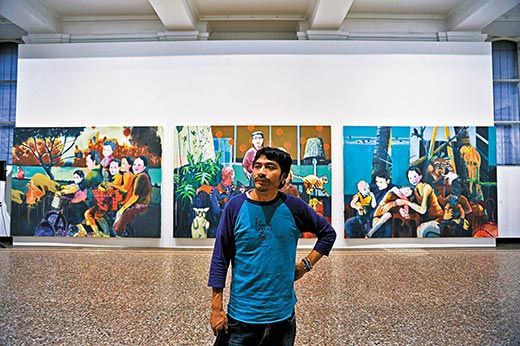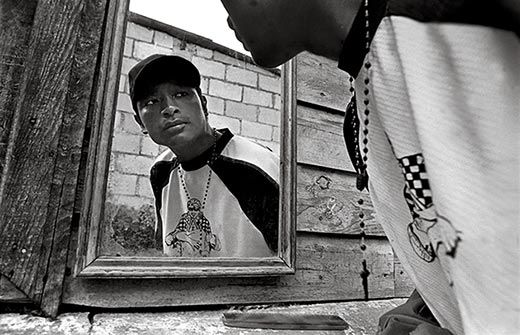Out of the Guatemalan Gang Culture, an Artist
Carlos Perez could have been an artist or a gangster. Photographer Donna DeCesare helped him choose
/https://tf-cmsv2-smithsonianmag-media.s3.amazonaws.com/filer/Indelible-Carlos-Perez-Donna-DeCesare-631.jpg)
Carlos Perez wishes now that he had burned his clothes instead of giving them away. He thinks mostly about his shirt—white, and emblazoned with the image of a dying gang member.
“It’s hard to think now that someone else is wearing the shirt, thinking it’s cool,” Perez says as he contemplates a photograph taken of him in 2001 in his family’s yard in the Guatemalan village of Magdalena Milpas Altas. He was 18 then—a budding artist, but also a member of the 18th Street Gang, a violent, illicit Los Angeles-based group that has gained ground in Guatemala and El Salvador.
“At the time, he really had a foot in both worlds,” says Donna DeCesare, who took the photograph. “He was starting to do a lot of art, but he was active in the gang. It was very clear he hadn’t made up his mind which one he’d go with.”
DeCesare, 55, a New York City native, has become internationally known for her work documenting the spread of U.S. gang culture to Central America. She won awards for From Civil War to Gang War, a photographic project on Salvadoran refugees getting involved in Los Angeles gangs. A multimedia sequel titled Hijos del Destino, or Destiny’s Children, was scheduled to go up on the Internet last month. “When kids have any kind of pull toward gangs, often they’ll say, ‘I’ll be dead soon,’” she says. “But Carlos told me early on that he didn’t believe in destiny and thought life was more a matter of influence.”
Perez’s early life was influenced principally by poverty and the violence of Guatemala’s 36-year civil war, which ended in 1996. His father, he says, was an alcoholic; his mother, Carmen, a midwife, raised their seven children. She sent Perez to a school several hours away from their home so her brother, a Catholic priest there, could look after him.
Perez was 11 when, he says, masked gunmen murdered his teacher. Gunmen also went after his uncle—Catholic clergy were suspected by the army of supporting the rebels—but he escaped and went into hiding. Not long afterward, Perez returned to his mother’s home.
Gradually, he sought safety in the brotherhood of gangsters. At the same time, he stayed in school and maintained a close relationship with his mother. “He didn’t want her to know about the gang, so he never got the trademark tattoos,” DeCesare says. “He really loved his mother a great deal, and I think she knew what he was up to, but it was never discussed.” Even now, Perez refuses to talk about what he did as a gang member.
In 2001 he met DeCesare, who spent a year photographing gangsters in and around Magdalena Milpas Altas. “There is an unwritten rule in gangs that you don’t let yourself be photographed,” Perez says. “But by the time Donna began photographing me, I’d gotten to know and trust her. She had seen some of the same [violence] I had.” Perez even helped her photograph members of rival gangs, avoiding the question of whether he was a gang member himself. “He’d say, ‘No, I’m the photographer’s assistant,’ ” DeCesare says. “That was a real breakthrough.”
Perez reached a turning point in 2002, when his mother died of ovarian cancer. “My mother had a deep psychological impact on me,” he says. “She saw a lot of extreme violence, a lot of death, because of the war. When I look back on it, I think that she showed me that I can take violence and turn it into something positive.”
He began easing himself out of the 18th Street Gang—which meant leaving its clothing, such as his white shirt, behind. “When I was trying to leave the gang and wore regular clothes, it made me feel so exposed,” he says. “Sometimes I’d put my gang shirt back on to feel safe.” Ultimately, he gave it away.
Meanwhile, DeCesare’s picture of Perez appeared in a Guatemalan newspaper with an article highlighting his artwork. At the time, his art was heavy on gang iconography and graffiti, but the story caught the attention of local United Nations officials. Eventually, he won a commission from them to illustrate a series of textbooks.
Shortly after his mother died, Perez heard from a schoolmate that an Austrian art school was interested in having more students from Central America. He launched an effort to get admitted and to organize his resources, including a scholarship, and in 2004 he enrolled in the Vienna Academy of Fine Arts, concentrating in painting.
He uses bold colors and large images, often of children. “I recognize in my art that I’m processing a lot of violence,” he says. “I don’t overdramatize it, but I think it’s there.”
Perez has already had three shows in Austria; he is working on another one while teaching a course in painting at an art school. When he graduated from the academy, last June, some of his paintings were hanging in a juried exhibition of students’ work. Perez dedicated the exhibition to his mother; DeCesare attended the ceremony as his guest. He intends to stay in Vienna, where he is living with his German-born girlfriend. He says he feels safe there.
Patti McCracken edited graphics for American newspapers for 15 years before moving to Europe. She now lives in Vienna.
Planning Your Next Trip?
Explore great travel deals
Smithsonian magazine participates in affiliate link advertising programs. If you purchase an item through these links, we receive a commission.

